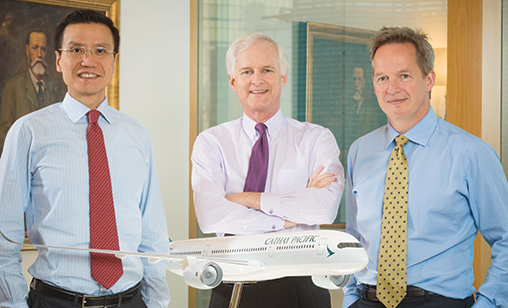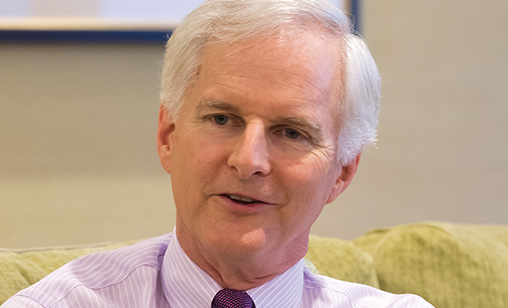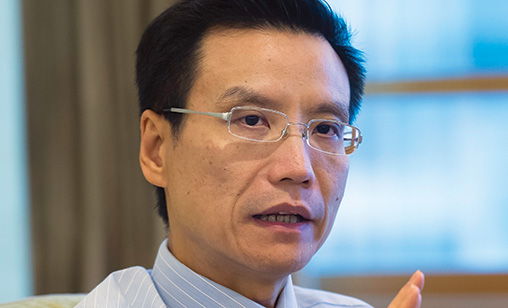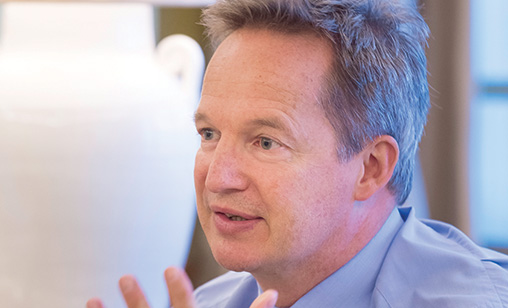Cover Story
Being irresistible
Cathay Pacific’s leadership triumvirate said the airline is “doing new and better things” continuously and is “certainly not going to stop now”.
June 1st 2016
Gathered in a Swire executive suite that takes in the sweep of Hong Kong’s iconic harbor and skyline, Cathay Pacific Airways’ John Slosar, Ivan Chu and Rupert Hogg could not look more relaxed. Read More » China’s economy might or might not be in serious trouble and the global growth outlook might be feeble. But when talking to Orient Aviation in Hong Kong last month, the carrier’s leadership triumvirate expressed a collective conviction that their airline charge is fit for purpose in a very competitive aviation world.
 |
| Photos: Graham Uden |
“Aviation has always had its ups and downs, depending on supply and demand, political shocks and everything else. I strongly suspect those will continue going forward,” said Slosar, the airline’s chairman, who also is chairman of the airline’s parent, Swire Pacific Limited.
“We have been around for 70 years so we have seen a number of ups and downs. We will always take proper steps to make sure we get through the downs and are there for the ups. Aviation in Asia has a long way to go. We think Hong Kong has established itself as the best hub in the middle of Asia and it is within our powers to continue to build on that. That’s exactly what we are trying to do.”
Fighting words indeed when the business of making money at an airline has never been tougher. Cathay faces competition from full service regional rivals, ambitious and fast growing low-cost carriers, capacity hungry Gulf airlines and the growing power of Mainland China’s major aviation groups. All of them, in different sectors of the market, are as intent as Cathay on building market share in the region – and beyond.
In the meantime, the airline has had to absorb fuel hedging losses of more than $1 billion for fiscal 2015. Despite these factors, Cathay reported a net profit of US$773 million in 2015, up 90% from a year earlier. It was its best result since 2010.
The good news came down to strong traffic and a focus on cost control, explained the airline’s chief executive, Ivan Chu. Cathay’s flights in 2015 had record load factors, with premium economy performing particularly well.
“In general, we had a very strong result on our regional and long-haul routes, particularly in the back end, with 93% to 94% [load factor] throughout the year. That’s incredible,” said Chu, who has been the airline’s boss since 2014.
| No holding off on hedging Cathay, which normally hedges between 50% and 60% of its fuel, may have been burnt last year by its fuel hedging policy, but it has no intention of ending the practice. Its current hedging contracts are declining year on year, said Cathay Pacific Airways chairman, John Slosar. “We are still relatively highly hedged, but next year it is less and the year after that we are pretty much out.” “We will continue to hedge. We have a hedging policy and where fuel is such a high percentage of your cost - at a low it’s still in the 30% range and at a high it’s in the 40% somewhere - some judicious hedging is an important thing to do. But hedging’s not easy. I wish I could say it was, but it’s not.” Slosar said the airline would continue to adapt and “nip and tuck” on that. “Who knows? It’s been low for a while. At some point, we’re going to wake up and discover it’s a lot higher than we thought it was. Then we will think thank goodness we’ve got a hedging policy,” he said. Future hedging will depend on fuel price levels. “You would obviously hedge a different percentage when it’s very high as opposed to when it’s very low. It takes that into account. You can’t make a fixed rule that is going to apply for the next 20 years. That’s not going to work,” said Slosar. |
“With the passenger side strong, the cost side was great, he added. “Even though we sustained a few hedging losses, the net saving was in the region of about 20%. We did very well on the non-fuel cost side. We grew capacity by 5%-6% last year, but costs did not grow to the same extent so we had efficiency and productivity gains from that.”
Chief operating officer Hogg added that Cathay’s costs without fuel, that is its unit costs, have come down every year since 2011. “We have been working on a whole lot of things that make us more productive, such as new technology. So, as ever, we have to totally manage our cost base.”
Critically for the carrier, a major fleet renewal is underway. Cathay Pacific operates 121 passenger airliners: 53 B777-300ERs, 12 B777-300s, five B777-200s, three B747-400s, five A340s, 42 A330-300s and the latest A350.
It has 68 new passenger jets on order: 22 A350-900s, 26 A350-1000s and 21 B777-9s. All of its B747s will be gone by year end and the A340s will follow suit next year. The airline’s first A350-900 arrived at the carrier at the end of May – Cathay’s first new aircraft type for 20 years. Eleven are expected to be delivered to its Hong Kong headquarters by December, bringing huge efficiencies and significant network opportunities with them. Annual growth for the airline is forecast at 4% to 5% in the next five to 10 years.
 |
| 'The industry has never ultimately been constrained by its infrastructure. It has found a way to keep that growth going. The onus is on us to work with everybody here in Hong Kong and the other airports around the region to find a way to keep it going. I would bet that we’ll find a way' |
| John Slosar Cathay Pacific Airways chairman |
“This is another very exciting epoch for Cathay Pacific with the introduction of the A350s,” said Hogg, who has been director cargo and then director sales and marketing before he succeeded Chu as COO in 2014.
“The first 22 of them are the 900 series that we are going to configure in three classes with 280 business, premium economy and economy seats. This configuration gives us the opportunity to open destinations on long thin routes and to do that really economically because the A350 is such an efficient aircraft.
“You will see more frequencies to places like Europe and a general expansion of our network there and elsewhere. The 26 A350-1000s, a bigger capacity aircraft and more like the B777 if you like, will allow us great flexibility between our 777 family, our 1000 family and our 900 family to increase services to Europe, Australasia and both coasts of the U.S.”
The A350 fleet is part of a strategy to counter the value proposition and threat of the Gulf carriers. “It will allow us to fly to secondary destinations in Europe in a very cost efficient manner. No doubt our passengers would want to fly non-stop rather than spending three hours or more in the Middle East,” said Chu. “We believe we can secure the high yield customers who want to have the convenience and the comfort of flying non-stop all the way to secondary airports. We will be doubling our destinations in Europe. The A350 is ideal for these routes and we will be very competitive.”
Cathay will not, however, be fixated on Europe. “We are a network airline. In order to keep it in balance we have to expand a bit everywhere,” said Slosar. “If you only expanded to one place you would end up with constraints in other places. There will be a focus on Europe, but in the past few years there has been tremendous growth to North America. That is not going to end.”
“China and the rest of Asia also are a hugely important part of the network. A lot of people come to Hong Kong and go onto other places so we have to expand to make sure we have connectivity and seats available. You have to get the whole thing to grow otherwise you will have a lot of seats in one place and no seats in the other and you won’t be able to take advantage of that.”
Hogg pointed there are always “bumpy periods” along the aviation path, but said: “We remain bullish about the prospects across the region. All the data shows the centre of global aviation is heading to this region. In terms of city pair volumes the top ten city pairs are now in Asia and six of the ten of them touch on Hong Kong. So the fundamentals are clearly there.”
One issue that remained an impediment to growth is air traffic congestion at Cathay’s home airport as well as other major airports in the region. “Definitely, the ability for infrastructure to grow with demand is going to be a factor in Asian aviation,” said Hogg.
| Cathay Pacific and Lufthansa forge cargo partnership In May, Cathay Pacific and Germany’s Lufthansa announced an agreement to co-operate on cargo operations. After Emirates, they are the second and third largest air cargo players in the world. The two airlines will work closely on network planning, sales, IT and ground handling. The goal is for the airlines’ customers to have access to the entire joint networks of the two carriers either through the partners’ booking systems or offering joint handling at their hubs in Hong Kong and Frankfurt. “We are well positioned and have a very big business in the trans-Pacific, joining the number one and two economies in the world of the U.S. and China. We think the Lufthansa deal will be really good for shippers and forwarders between here and Europe. It makes a lot of complementary sense,” said Cathay Pacific’s chief operating officer, Rupert Hogg. Despite the sluggish nature of the cargo sector, he added Cathay Cargo is managing to operate at about 64% load factor across its fleet, which “keeps our head above water”. |
“In Hong Kong itself we are reasonably confident the third runway will open in around seven or eight years. We’ve a plan to allow us to grow. We are working very closely with the airport authority, other partners and suppliers to minimize active disruption when it [congestion] happens.
“We have done a lot of work on this. We are beginning to see some results coming through in terms of on-time performances. It’s quite encouraging.”
Slosar also is optimistic. “There’s a great deal of co-operation among those involved, at a very high level. Everybody knows we are facing a period when we must optimize to extract the most from what is there. There always are things you can do and we will do everything we can within that period to make it work,” he said.
“The Hong Kong hub is huge for us. It’s home. It is still the biggest aviation passenger hub in Asia. We need to make sure it stays efficient and continues to work like the well-oiled machine that it is.”
 |
| 'We are not worried about competition, low-cost or otherwise, because we see big growth, not just in China but all over Asia and the rest of the world. We are not worried about the demand situation as long as we do our things right, making sure we look after our customers' |
| Ivan Chu Cathay Pacific Airways chief executive |
He said “the industry has never ultimately been constrained by its infrastructure. It has found a way to keep that growth going. The onus is on us to work with everybody here in Hong Kong and the other airports around the region to just find a way to keep it going. I would bet that we’ll find a way”.
One worry, particularly for Cathay, is cargo operations. With air freight still in the doldrums group cargo revenue in 2015 dropped 9%, to $2.9 billion, compared with the previous year. “We are a very big cargo operator. It’s always been a great business for us,” said Hogg. “We are probably one of the largest combination carriers – belly and freighter – and we think for some time to come this region will be the manufacturing centre for the world. So it’s a sensible business for us to be in.
“The trends are sort of universal. For the first time, volumes have grown at a slower rate than GDP. There’s also a lot more passenger belly capacity around. So yes, there are definitely some challenges, although the low fuel price has allowed us to keep operating aircraft we might not have done otherwise.”
Cathay has always taken pride in its service standards and it does not intend to ease up on that front. At the airline’s most recent shareholder meeting, held in Hong Kong, one investor accused Cathay of no longer being a premium airline, a charge Slosar strongly disputed.
“My response was we do a lot of research with our customers and that’s not what they are saying. We don’t do it by talking to a few people. We do quite serious research to keep track of what people think about us. We are not seeing that trend at all,” he said.
Cathay is an “unabashed believer” in the multi segment full-service model. “It has worked well and we think it has a lot of legs going forward. Don’t necessarily listen to what we say, look at what we do. We continue to launch and develop what we think are industry-leading products in seats, lounges and new planes that complete the passenger travel experience from the start of the journey to the end,” he said.
Chu said the goal is to maintain consistently high quality at Cathay and at its 100%-owned subsidiary, Cathay Dragon. “It’s what we do every single day. For someone to say to us you are not premium any more is actually to us quite emotional. I can detail so many examples of the amount of capital we have invested in the airlines - last year it was more than HK$7 billion (US$901 million) on cabins and lounges,” he said.
“We are taking delivery of 70 aircraft with list prices of HK$180 billion ($23.2 billion) and they all come with better seats. Even though we already have the best business class seats we are improving them.
| Both sides “want to do a deal” in pilots’ dispute A troublesome issue for Cathay Pacific is a continuing work to rule by members of the Hong Kong Aircrew Officers Association (HKAOA), which represents 2,100 of Cathay Pacific’s 2,900 pilots. Cathay Pacific’s chief executive, Ivan Chu, believes the parties are moving closer to a deal. Initially implemented at the airline because of a pilot pay dispute, which was ultimately resolved, the industrial action has overflowed into a dispute about other cockpit crew working conditions, including roster patterns. The work to rule has forced Cathay to defer the launching of some routes. “We are talking to them. That’s the good news,” said Chu. “We have been going through this very uncomfortable and unsettled situation with our pilot union, but we are, hopefully, in the final rounds of discussion with them. We have been making some headway and both sides want to do a deal,” Chu told Orient Aviation. |
“For us, when we think about new product and new lounges we always ask ourselves three questions. Number one, what’s new? Number two, is it better? Number three, is it better than our competitors? You can see tons of evidence that we are constantly spending capital making sure we continue to be the best.”
Cathay unveiled a revised livery in November. As well, all Cathay and Cathay Dragon wide body passenger aircraft have been fitted or retro-fitted with new or refreshed seats in all classes. The A350s will have a new cabin design and better seats and inflight entertainment systems. The first class lounge at The Pier at Hong Kong International Airport has been very well received and the Business Class Pier lounge, the biggest in Asia after a year of refurbishment, will be ready for guests soon. New lounges also have been opened in Manila, Bangkok, San Francisco and Taipei.
“We sometimes forget it’s a consumer business because we focus on planes and all that kind of stuff,” said Slosar. “The reality at the consumer end is that every time somebody travels they have a choice. We need to make it an irresistible choice to keep coming back to us, which means we can’t stand still. We’ve got to do new and better things continuously. If you look back on the last decade of Cathay that’s exactly what we’ve done and we are certainly not stopping now.”
Cathay has re-named its regional subsidiary from Dragonair to Cathay Dragon. Why was it necessary? “It’s a great airline. It has a strong following and a strong clientele. Its network complements the Cathay Pacific network,” said Hogg. “The principle reason for rebranding is to make sure that travellers in China or Australia or America understand the two airlines are unequivocally from the same premium stable.
“We needed a visual way of doing that. We needed a linking of the names that reinforced that vision. If you look at China and the number of first time travellers there and then think of people from our increasing American network, they need to feel that if they are going on a one-stop itinerary over the Hong Kong hub they will be looked after to the same standard, with the same professionalism, throughout the journey. That’s the reason for doing it and we are very excited about it. Cathay Dragon will continue to grow, not only in China but across the region,” he said.
 |
| 'We remain bullish about the prospects across the region. All the data shows the centre of global aviation is heading to this region. In terms of city pair volumes the top ten city pairs are now in Asia and six of the ten touch on Hong Kong. So the fundamentals are clearly there' |
| Rupert Hogg Cathay Pacific Airways chief operating officer |
Cathay’s position on low-cost carrier competition and its refusal to start an LCC subsidiary is well known and is unchanged.
“The assumption people often make is that LCCs have a cost advantage,” said Slosar. “They don’t often. Where we fly a route with a 420-seat B777-300 regional plane, with cargo and premium passengers, for sure the net cost to us of our economy class seat is lower than most LCCs. We can compete with them on these routes and we have done.”
Cathay makes the point that low-cost or whatever it is called is irrelevant to consumers. “They’re just offerings in the market place. Passengers don’t say: I’ll take you because you have this business model. They say I will take you because you’re giving me the best value. That may be cost or schedule or things like ‘I can watch TV programs for free on a three-hour flight’,” said Slosar.
“We say we’re not going to get hung up about the business model. We’re going to get really hung up about making sure we are offering value in the market place.”
Elsewhere, he suggested, incumbent airlines have permitted the market growth to go to new entrants. Cathay won’t allow that to happen.
“We will find a way to make sure we participate in that growth. Strategically, that’s a hugely important decision to make, to say we will not allow ourselves to just sit back and let the growth go elsewhere,” he said.
In the meantime, Cathay must manage an emerging global trend; a slowdown in traffic growth compared with previous high levels.
“Hong Kong is growing at 1% to 1.5% this year. On the passenger side we are seeing some softening. If you look at the trends in the last 18 months there are some weak trends in front-end travel with corporates around the world cutting back, particularly the financial sectors,” Chu said.
“In terms of load factor, however, we are still better than our peers in the region. In 2015, we achieved an 86% plus load factor. So far this year, it is 84%, although 84%, by all accounts, is higher than most of our competitions in the region. Last year, we were about 7% higher and this year it is 5% to 6% higher.”
Whatever the market conditions, Cathay is far from pessimistic about its future. “There is still huge opportunity for Cathay Pacific as long as we invest in the brand and invest in the product as well as service,” said Chu.
“Cathay is not known just for the hardware, but for the great service that is provided by more than 10,000 cabin crew. That service is at a consistent, high quality level. It is what we stand for. I don’t think we should worry about passenger demand too much because over the years our customers have voted consistently with us.
“We are not worried about competition, low-cost or otherwise, because we see big growth, not just in China but all over Asia and the rest of the world. We are not worried about the demand situation as long as we do our things right, making sure we look after our customers.
“The challenge for us is to continue to maintain that investment in product and services and to be focused on costs. Ensuring a consistent, high quality service is absolutely critical for us going forward.”